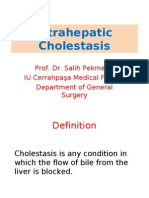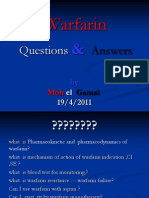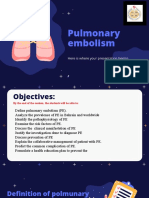Deep Venous Thrombosis Harrison's
Deep Venous Thrombosis Harrison's
Uploaded by
Maria Agustina Sulistyo WulandariCopyright:
Available Formats
Deep Venous Thrombosis Harrison's
Deep Venous Thrombosis Harrison's
Uploaded by
Maria Agustina Sulistyo WulandariOriginal Description:
Copyright
Available Formats
Share this document
Did you find this document useful?
Is this content inappropriate?
Copyright:
Available Formats
Deep Venous Thrombosis Harrison's
Deep Venous Thrombosis Harrison's
Uploaded by
Maria Agustina Sulistyo WulandariCopyright:
Available Formats
Deep Venous Thrombosis
Maria Agustina S.W. (130110100119)
Definition
Ada thrombus di deep vein Biasanya disertai inflamasi vessel wall (thrombophlebitis) The major clinical consequence is embolization, most frequently to the lung
Predisposing factors: vascular stasis, vascular damage, and hypercoagulability (Virchows triad). Thrombus is composed principally of platelets and fibrin. Karakteristik respon inflamasi di vessel wall: o Granulocyte infiltration o Loss of endothelium o Edema
Epidemiology
Deep venous thrombosis (DVT) 1000 per 100,000 persons annually in the general population > 60 years of age >50% of patients having orthopedic surgical procedures, particularly those involving the hip or knee 10%40% of patients who undergo abdominal or thoracic surgery Venous thromboembolism (VTE): DVT and pulmonary embolism VTE-related deaths in the U.S. are estimated at 300,000 annually. 7% diagnosed with VTE and treated 34% sudden fatal pulmonary embolism 59% as undetected pulmonary embolism
Symptoms & Signs
DVT of the iliac, femoral, or popliteal veins Calf pain Unilateral leg swelling Warmth Erythema Tenderness along the course of the involved veins o Palpable cord o Increased tissue turgor o Distention of superficial veins o Appearance of prominent venous collaterals o Increased resistance or pain during dorsiflexion of the foot (Homans sign) o Phlegmasia cerulea dolens (cyanotic) o Phlegmasia alba dolens (pallor) o In extreme cases, patient is unable to walk Upper-extremity DVT o Occurs less frequently o Incidence is increasing because of: Greater use of indwelling central venous catheters More frequent insertion of permanent pacemakers and internal cardiac defibrillators o Clinical features and complications are similar to those described for the leg. In both upper- and lower-extremity DVT, ~5% of patients have no symptoms.
o o o o o
Risk Factors
Usually, DVT is due to multiple risk factors. Surgery: orthopedic, thoracic, abdominal, and genitourinary procedures Neoplasms: pancreas, lung, ovary, testes, urinary tract, breast, stomach Trauma: fractures of spine, pelvis, femur, or tibia Immobilization o Acute myocardial infarction o Congestive heart failure o Stroke o Postoperative convalescence o Extended time in seated position Pregnancy: ppada trimester 3 dan 1 bulan postpartum Estrogen use: kontrasepsi atau hormone replacement Hypercoagulable states Resistance to activated protein C Venulitis (e.g. TOA) Previous DVT Age > 50 years Obesity Air pollution Cigarette smoking Eating large amounts of red meat Varicose veins Oral corticosteroid use Inflammatory bowel disease
Differential Diagnosis
Disorders that cause unilateral leg pain or swelling: Muscle rupture Trauma Hemorrhage Ruptured popliteal cyst Lymphedema Postphlebitic syndrome/venous insufficiency Nerve compression Arthritis Tendonitis Fractures Arterial occlusive disorders Cellulitis
Etiology
Diagnostic Approach
Dibutuhkan assessment of pretest likelihood of DVT using Wells criteria, D-dimer testing dan ultrasonography.
Clinical assessment of pretest probability of DVT (Wells criteria) Clinical feature Active cancer Paralysis, paresis, or recent plaster Recently bedridden 3 days, major surgery requiring general anesthesia within previous 12 weeks Localized tenderness along deep venous system Entire leg swollen Calf swelling > 3 cm compared with asymptomatic side (measured 10 cm below tibial tuberosity) Pitting edema confined to symptomatic leg Collateral superficial veins (nonvaricose) Previously documented DVT Alternative diagnosis at least as likely as DVT Low clinical likelihood of DVT = 0 or less Moderate likelihood of DVT= 12 High likelihood of DVT = 3 In patients with symptoms in both legs, the more symptomatic leg is used. Score 1 1 1
International normalized ratio (INR) Monitor the prothrombin time in patients receiving warfarin Target value: 22.5
Imaging
Duplex venous ultrasonography B-mode: 2-dimensional imaging and pulse-wave Doppler interrogation o The noninvasive test used most often to diagnose DVT o Sensitivity of duplex venous ultrasonography approaches 95% for proximal DVT and 75% for symptomatic calf vein thrombosis. o Criteria for diagnosis of acute DVT: Lack of vein compressibility (the principal criterion) Vein does not wink when gently compressed in cross-section. Failure to appose the walls of the vein due to passive distension CT/ MRI Venography (venous ultrasonography) o Menggunakan medium kontras yang diinjeksikan ke superficial vein kaki.
o
1 1 1
1 1 1 -2
Treatment Approach
Anticoagulation is the primary treatment. Benefits of anticoagulation o Prevention of pulmonary embolism is the most important reason for treating DVT. o Anticoagulants prevent thrombus propagation and allow the endogenous lytic system to operate.
Clinical algorithm D-dimer adalah test pertama yang dilakukan pada pasien dengan low-tomoderate pretest probability of DVT. Ultrasonography adalah test pertama yang dilakukan pada pasien dengan high pretest probability of DVT. Hipotesis DVT bisa disingkirkan jika pasien low-to-moderate pretest probability of DVT dan negative D-dimer testing. Jika D-dimer elevasi imaging. Pasien dengan high pretest probability of DVT dan negative ultrasonogram D-dimer test. If D-dimer testing is negative, not DVT. Pasien high pretest probability of DVT, negative ultrasonogram, positive Ddimer repeat ultrasonography in 57 days.
Duration of anticoagulation
Laboratory Tests
D-dimer A degradation product of cross-linked fibrin o Levels naik pada pasien dengan thrombosis. o A sensitive (>80%), but not specific. Baseline blood urea nitrogen and creatinine measurement, complete blood count o Diperiksa sebelum treatment dengan unfractionated or low-molecularweight heparin (LMWH). Partial thromboplastin time (PTT) o Monitor anticoagulation in patients receiving unfractionated heparin Target: 1.52.5 times control value
Isolated upper extremity or calf DVT provoked by surgery, trauma, estrogen, or an indwelling central venous catheter or pacemaker: 3 months of anticoagulation Provoked proximal leg DVT or pulmonary embolism: 36 months of anticoagulation Pregnant women with acute VTE should be treated for at least 6 months, including up to 6 weeks postpartum. Patients with recurrent DVT: indefinite
Specific Treatments
Anticoagulant therapy
Initial therapy should include unfractionated heparin or LMWH. Unfractionated heparin should be administered intravenously. o Initial bolus of 80 U/kg o Followed by a continuous infusion of 18 U/kg per hour, and check PTT in 6 hours o Rate of infusion should be adjusted so that the aPTT is approximately twice the control value.
In < 5% of patients, heparin therapy may cause thrombocytopenia. Low-molecular-weight (40006000 Da) heparins
Pregnant women with acute VTE should be treated for at least 6 months, including up to 6 weeks postpartum
Inferior vena cava filter
Complications
Pulmonary embolism Post-thrombotic syndrome (also known as post-phlebitic syndrome or chronic venous insufficiency) o Chronic pain and swelling o Occurs in more than half of patients with DVT o Late adverse effect of DVT that is caused by permanent damage to the venous valves of the leg o May not become clinically manifest until several years after the initial DVT o No effective medical therapy o Most patients describe chronic ankle swelling and calf swelling and aching, especially after prolonged standing. o Most severe form: skin ulceration, especially in the medial malleolus of the leg Chronic venous insufficiency Major bleeding secondary to anticoagulation treatment Complications of heparin or LMWH therapy o Hemorrhage o Heparin-induced thrombocytopenia o Osteopenia o Thrombosis
Indications o When treatment with anticoagulants is contraindicated (e.g., active bleeding) o Patients in whom anticoagulation therapy fail Optional long-term benefit requires concomitant anticoagulation as the filter is itself thrombogenic. o Filters double the DVT rate over the ensuing 2 years after placement.
Thrombolytic drugs
Examples: urokinase, alteplase (tissue plasminogen activator) Early administration of thrombolytic drugs may: o Accelerate clot lysis o Preserve venous valves o Decrease the potential for developing postphlebitic syndrome o Increase the risk of bleeding compared with heparin Generally only used for patients with: o Limb-threatening thrombosis and o Symptoms for < 7 days and o Low risk of bleeding
Monitoring
Platelet count should be checked after 3 days of heparin therapy. Once a therapeutic INR (>2.5) has been achieved, INR should be checked: o Twice weekly for first 2 weeks o Then once weekly until stable o Then every 24 weeks Test for thrombophilic states. Duration of anticoagulation therapy o Patients with major transient risk factor: 3 months o Idiopathic DVT: 6 months o Indefinite treatment Protein C, protein S, or antithrombin deficiency Persistent antiphospholipid antibodies Homozygosity for factor V Leiden or prothrombin gene mutation Ongoing risk major risk factor (cancer) Recurrent idiopathic thromboembolism o Cancer and VTE: 36 months of LMWH as monotherapy without warfarin and to continue anticoagulation indefinitely unless the patient is rendered cancerfree
Prognosis
Prognoosis bagus untuk pasien yang menerima terapi antikoagulan. DVT kembali 5-10% selama 1 tahun berhenti terapi antikoagulan. Within 8 years, DVT recurs in ~30% of patients.
Prevention
General
Prophylaxis penting pada pasien dengan resiko tinggi DVT Treatment options include: o Low-dose unfractionated heparin (MiniUFH) 3 times daily o LMWH o Intermittent pneumatic compression devices (IPCs) o Vascular compression stockings
Prevention of postphlebitic syndrome Satu-satunya terapi untuk mencegah postphlebitic syndrome adalah dengan menggunakan below-knee 3040 mmHg vascular compression stockings.
Source: Harrisons
You might also like
- Essentials of Internal MedicineDocument832 pagesEssentials of Internal MedicineEmanuelMC100% (82)
- Acute Appendicitis: Complications & TreatmentDocument28 pagesAcute Appendicitis: Complications & Treatmentsimi yNo ratings yet
- Extrahepatic CholestasisDocument31 pagesExtrahepatic Cholestasismackiecc100% (1)
- Deep Vein Thrombosis: Faculty of Medicine University of BrawijayaDocument59 pagesDeep Vein Thrombosis: Faculty of Medicine University of BrawijayaAgung IndraNo ratings yet
- The Ultimate Guide to Vascular Ultrasound: Diagnosing and Understanding Vascular ConditionsFrom EverandThe Ultimate Guide to Vascular Ultrasound: Diagnosing and Understanding Vascular ConditionsNo ratings yet
- Radiology of The Urinary SystemDocument78 pagesRadiology of The Urinary Systemapi-19916399No ratings yet
- Vascular Disease Approach 11-7-13Document65 pagesVascular Disease Approach 11-7-13Dian PuspaNo ratings yet
- Oncological EmergencyDocument80 pagesOncological Emergencybonsazewdie2883No ratings yet
- Kuliah CviDocument33 pagesKuliah CviAliffiaNo ratings yet
- Vascular RehabilitationDocument10 pagesVascular RehabilitationSuman DeyNo ratings yet
- Differential Diagnosis of A Renal MassDocument23 pagesDifferential Diagnosis of A Renal Massmdjohari100% (1)
- AP WindowDocument13 pagesAP WindowHugo GonzálezNo ratings yet
- Abdominal Aortic AneurysmDocument1 pageAbdominal Aortic AneurysmIron ForceNo ratings yet
- Case Presentation (00662100) : 51 Yr-Old Female With Multiple Comorbidities (HTN, Ibs, Gerd, and Recurrent Utis)Document32 pagesCase Presentation (00662100) : 51 Yr-Old Female With Multiple Comorbidities (HTN, Ibs, Gerd, and Recurrent Utis)JohnyNo ratings yet
- CHD2 - DR Shirley L ADocument74 pagesCHD2 - DR Shirley L ARaihan Luthfi100% (1)
- Cardiac Masses: Nick Tehrani, MDDocument77 pagesCardiac Masses: Nick Tehrani, MDNuha AL-Yousfi100% (1)
- Periphral Vascular Disease 2Document44 pagesPeriphral Vascular Disease 2Sohil ElfarNo ratings yet
- Renal Artery StenosisDocument80 pagesRenal Artery StenosisAnn FloydNo ratings yet
- Schwartz2002 PDFDocument7 pagesSchwartz2002 PDFnova sorayaNo ratings yet
- Clinical Manifestations and Diagnosis of Urinary Tract Obstruction and Hydroneph PDFDocument32 pagesClinical Manifestations and Diagnosis of Urinary Tract Obstruction and Hydroneph PDFAmjad Saud0% (1)
- PlethysmographyDocument2 pagesPlethysmographyFaraz ThakurNo ratings yet
- Extrahepatic Biliary ObstructionDocument44 pagesExtrahepatic Biliary ObstructionOssama Abd Al-amierNo ratings yet
- Catheter Directed Thrombolysis: Gan Dunnington M.D. Stanford Vascular Conference 9/12/05Document25 pagesCatheter Directed Thrombolysis: Gan Dunnington M.D. Stanford Vascular Conference 9/12/05Pratik SahaNo ratings yet
- Amputation in Lower LimbsDocument35 pagesAmputation in Lower LimbsSamNo ratings yet
- Venous DiseaseDocument50 pagesVenous Diseasesgod34No ratings yet
- Acute Compartment Syndrome of The ForearmDocument4 pagesAcute Compartment Syndrome of The ForearmsalamsibiuNo ratings yet
- Pulmonary SequestrationDocument15 pagesPulmonary SequestrationEmily EresumaNo ratings yet
- Peripheral Vascular Disease - Wikipedia, The Free EncyclopediaDocument5 pagesPeripheral Vascular Disease - Wikipedia, The Free EncyclopediaDr. Mohammed AbdulWahab AlKhateebNo ratings yet
- DVT ProphylaxisDocument30 pagesDVT ProphylaxisedhsnzktNo ratings yet
- Minimally Invasive AdrenalectomyDocument14 pagesMinimally Invasive AdrenalectomyTJ LapuzNo ratings yet
- Vascular Malformations Part IIDocument24 pagesVascular Malformations Part IIJuan RomeroNo ratings yet
- Pulmonary Embolism.2020Document11 pagesPulmonary Embolism.2020qayyum consultantfpscNo ratings yet
- Current Concepts in Hemorrhagic ShockDocument12 pagesCurrent Concepts in Hemorrhagic ShockktorooNo ratings yet
- Varicose Vein Treatment Tips and Trick - Ablation or GlueDocument30 pagesVaricose Vein Treatment Tips and Trick - Ablation or GlueNata NakamuraNo ratings yet
- HERNIADocument70 pagesHERNIAmwro789000No ratings yet
- Acute Abdominal Pain: Associate Professor, Dept. of Surgery Mti, KMC, KTHDocument45 pagesAcute Abdominal Pain: Associate Professor, Dept. of Surgery Mti, KMC, KTHWaleed MaboodNo ratings yet
- Pericardial Diseases 3rd Yr BMTDocument38 pagesPericardial Diseases 3rd Yr BMT211941103014100% (1)
- Mass in Epigastrium-2Document37 pagesMass in Epigastrium-2brown_chocolate87643100% (1)
- Ulcerativecolitis 170323180448 PDFDocument88 pagesUlcerativecolitis 170323180448 PDFBasudewo Agung100% (1)
- Lecture 4 Biliary TreeDocument31 pagesLecture 4 Biliary TreeattooNo ratings yet
- K-25 Acute AppendicitisDocument23 pagesK-25 Acute AppendicitiscarinasheliapNo ratings yet
- Venous DisDocument41 pagesVenous DisAdel SalehNo ratings yet
- Warfarin Q and ADocument40 pagesWarfarin Q and AAbdul-Rhman Hamdy KishkNo ratings yet
- An Imaging Checklist For Pre-FESS CT - Framing A Surgically Relevant Report-Clinical Radiology-2011Document12 pagesAn Imaging Checklist For Pre-FESS CT - Framing A Surgically Relevant Report-Clinical Radiology-2011Jose ManuelNo ratings yet
- Ultrasound PrinciplesDocument61 pagesUltrasound PrinciplestmudigonNo ratings yet
- Vasc Med 2006 Gerhard Herman 183 200Document19 pagesVasc Med 2006 Gerhard Herman 183 200Ahmad ShaltoutNo ratings yet
- Renal CystsDocument13 pagesRenal CystsDwi AryanataNo ratings yet
- Esophageal Motility DisordersDocument43 pagesEsophageal Motility DisordersmokhtarNo ratings yet
- Endovascular Surgery - BenkőDocument33 pagesEndovascular Surgery - BenkőpampaszNo ratings yet
- Approach To Patient With Splenomegaly 2Document57 pagesApproach To Patient With Splenomegaly 2Saja SaqerNo ratings yet
- Deep Venous Thrombosis 2022. ANNALSDocument20 pagesDeep Venous Thrombosis 2022. ANNALSErnesto LainezNo ratings yet
- Varicose Veins & DVTDocument9 pagesVaricose Veins & DVTJuan Miguel BastidasNo ratings yet
- 2 - Vascular InjuryDocument6 pages2 - Vascular Injuryمحمد عماد عليNo ratings yet
- Biliary Surgery: Presenter: DR Muhuga JR Facilitator: DR MwashambwaDocument54 pagesBiliary Surgery: Presenter: DR Muhuga JR Facilitator: DR MwashambwaSamar AhmadNo ratings yet
- Right Heart Catheterization, NicvdDocument17 pagesRight Heart Catheterization, NicvdNavojit ChowdhuryNo ratings yet
- Onco 4 Prostate CancerDocument30 pagesOnco 4 Prostate CancerTej Narayan Yadav100% (1)
- Central Line PlacementDocument49 pagesCentral Line PlacementAndresPimentelAlvarezNo ratings yet
- Basics of Breast UltrasoundDocument54 pagesBasics of Breast UltrasoundMaría VargasNo ratings yet
- Vascular SystemDocument218 pagesVascular SystemHeli MalivadNo ratings yet
- Growth Comparison in Children With and Without Food Allergies in 2 Different Demographic PopulationsDocument7 pagesGrowth Comparison in Children With and Without Food Allergies in 2 Different Demographic PopulationsMaria Agustina Sulistyo WulandariNo ratings yet
- Clinical Communications: Caroline B. Hobbs, MD, Asheley C. Skinner, PHD, A. Wesley Burks, MD, and Brian P. Vickery, MDDocument3 pagesClinical Communications: Caroline B. Hobbs, MD, Asheley C. Skinner, PHD, A. Wesley Burks, MD, and Brian P. Vickery, MDMaria Agustina Sulistyo WulandariNo ratings yet
- Reading Normal ECG - Maria A.S.WDocument18 pagesReading Normal ECG - Maria A.S.WMaria Agustina Sulistyo WulandariNo ratings yet
- Obstructive Jaundice: Case Report SessionDocument7 pagesObstructive Jaundice: Case Report SessionMaria Agustina Sulistyo WulandariNo ratings yet
- Anatomi Sistem Pernafasan Anatomi Sistem Pernafasan: Maria Agustina S.W 1301-1213-0554Document13 pagesAnatomi Sistem Pernafasan Anatomi Sistem Pernafasan: Maria Agustina S.W 1301-1213-0554Maria Agustina Sulistyo WulandariNo ratings yet
- Thromboprophylaxis in The ICUDocument31 pagesThromboprophylaxis in The ICUdocansh100% (1)
- Leadershp Strategy Analysis Paper FinalDocument10 pagesLeadershp Strategy Analysis Paper Finalapi-240099055No ratings yet
- CR 481Document9 pagesCR 481danielleclimacoNo ratings yet
- Disseminated Intravascular Coagulation in Infants and ChildrenDocument40 pagesDisseminated Intravascular Coagulation in Infants and Childrenkabulkabulovich5No ratings yet
- Thrombosis ManagementDocument14 pagesThrombosis ManagementJessa MaeNo ratings yet
- Cirona-6300 IFUDocument4 pagesCirona-6300 IFUOsvaldo CalderonUACJ0% (1)
- D-Dimer Antigen Current Concepts and Future Prospe-2Document40 pagesD-Dimer Antigen Current Concepts and Future Prospe-2fajar jamaloedinzNo ratings yet
- Deep Vein Thrombosis: EssentialsDocument7 pagesDeep Vein Thrombosis: EssentialsLuthfia RahmaditaNo ratings yet
- HRT Formulary and Treatment Guidance: (Apc Clindoc 010)Document8 pagesHRT Formulary and Treatment Guidance: (Apc Clindoc 010)psdsportsdocNo ratings yet
- Management of Patients With Non Malignant Hematologic DisordersDocument137 pagesManagement of Patients With Non Malignant Hematologic Disordersmaeantonette.orlinaNo ratings yet
- Unclogging The Effects of The Angiojet Thrombectomy System On Kidney Function: A Case ReportDocument6 pagesUnclogging The Effects of The Angiojet Thrombectomy System On Kidney Function: A Case ReportBruno CoutinhoNo ratings yet
- 5 Deep Vein Thrombosis Nursing Care PlansDocument7 pages5 Deep Vein Thrombosis Nursing Care PlansSubhranil MaityNo ratings yet
- Tranexamic Acid in Gastrointestinal Bleeding A.35Document7 pagesTranexamic Acid in Gastrointestinal Bleeding A.358ryd7prmdgNo ratings yet
- Stroke 2016 WinsteinDocument73 pagesStroke 2016 WinsteinTegar Fadeli ArrahmaNo ratings yet
- Dosis de Enoxaparina en Pesos ExtremosDocument12 pagesDosis de Enoxaparina en Pesos ExtremosJorgeNo ratings yet
- Pulmonary Embolism (PE) PDFDocument9 pagesPulmonary Embolism (PE) PDFMileNo ratings yet
- J American Geriatrics Society - 2023 - American Geriatrics Society 2023 Updated AGS Beers Criteria For PotentiallyDocument30 pagesJ American Geriatrics Society - 2023 - American Geriatrics Society 2023 Updated AGS Beers Criteria For PotentiallyIstiNo ratings yet
- Hematology MCQDocument19 pagesHematology MCQshamseerNo ratings yet
- Warfarin Perioperative ManagementDocument8 pagesWarfarin Perioperative Managementzoran cukovicNo ratings yet
- About Xarelto Clinical StudiesDocument5 pagesAbout Xarelto Clinical StudiesPieter HazmenNo ratings yet
- Delrosario 2017Document33 pagesDelrosario 2017Pande Agung MahariskiNo ratings yet
- Deep Venous Thrombosis Harrison'sDocument3 pagesDeep Venous Thrombosis Harrison'sMaria Agustina Sulistyo WulandariNo ratings yet
- Resource Chart Medical Eligibility Contraceptives EnglishDocument1 pageResource Chart Medical Eligibility Contraceptives EnglishGoh Zheng YuenNo ratings yet
- Oral Anticoagulant Therapy-When Art Meets Science: Clinical MedicineDocument17 pagesOral Anticoagulant Therapy-When Art Meets Science: Clinical MedicineMihaela MocanNo ratings yet
- Puerperal Venous ThrombosisDocument25 pagesPuerperal Venous ThrombosisAnitha ThankappanNo ratings yet
- Deep Vein ThrombosisDocument193 pagesDeep Vein Thrombosisdoctor_pepper0% (1)
- SCE Geriatrics CompressedDocument434 pagesSCE Geriatrics CompressedFaris FirasNo ratings yet
- Pulmonary Embolism: Here Is Where Your Presentation BeginsDocument39 pagesPulmonary Embolism: Here Is Where Your Presentation BeginsAsmaa ahmedNo ratings yet
- Department of Health Vte Risk Assessment Tool PDF 4787149213Document2 pagesDepartment of Health Vte Risk Assessment Tool PDF 4787149213Hosam MahmoudNo ratings yet






























































































